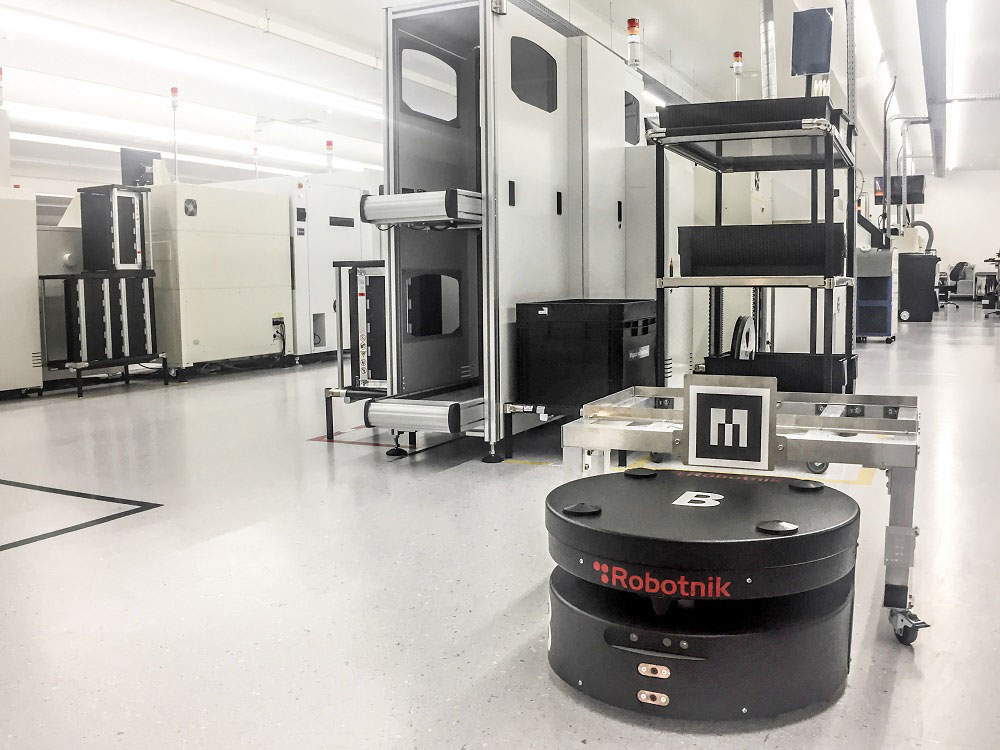- Robotic Automation: Deliveries for small logistics.
- Robotic automation and collaborative robots are no longer only available to large companies.
Robotnik is involved in many projects that give SMEs the possibility to implement autonomous mobile robots and become part of Industry 4.0.
One of these projects is the RB-LOG: Robotic Logistics, which has revolved around developing a new cost-effective indoor robotic transport solution that is especially suitable for deliveries for small residences, hotels, supermarkets, robotic in warehouses, and other small semi-structured buildings and will automate the transport process and free manpower for the tasks that require it.
After these years of experience in the sector, we have worked with small industry customers who were looking for new solutions to improve their products and make tasks more rentable, and we have seen how the introduction of collaborative robots, really gave a 360º turn to the SME.
Robotic Automation, should we choose between robots or employees?
There is a certain perception in small and midsize companies that cobots and collaborative mobile robotics, in general, threaten the jobs of employees. The reality is quite different: collaborative robotics has come to guarantee the future of the company by making it cost-effective, thus making it possible for those jobs to be maintained.
As we read in an article by the IFR (International Federation of Robotics):
‘Manufacturers and logistics providers are under increasing pressure to produce and ship smaller, customized orders in short timeframes. Many are automating the production process to be able to respond more efficiently to new orders. Some are also restructuring production and logistics, moving from linear production and logistics lines to a series of standard production cells which can be rapidly reconfigured to the task at hand.’
‘Small and mid-sized manufacturers (SMEs) form the backbone of most manufacturing economies, but many have been slow to automate. A number of developments are changing this. First, robots are now easier to program and re-task, throught intuitive interfaces and demonstration. Second, the new generation of collaborative robots can easily be integrated into existing production processes alongside workers – versus replanning the whole production line for automation’.
At the end of the H2020 project, in which Robotnik has participated as coordinators, we can draw conclusions and determine whether it has met the initial objectives.
RG-LOG: autonomous logistics transport
Although it is true that automated transport solutions already existed for large structured environments, they did not exist for smaller buildings or semi-structured environments. The goal was to develop a new, low-cost indoor robotic conveyor solution that would be particularly suitable for small residences, shops, hotels, supermarkets and warehouses where the material handling process could be automated, freeing up employee time for more value-added tasks.
In other words: for autonomous inland logistics transport in small buildings in semi-structured human environments.
To this purpose, Robotnik has collaborated with UBITECH and SingularLogic Cy to develop RB-LOG, a modular and adaptable hardware and software system, composed of autonomous transport robots that will be coordinated by an intuitive and flexible Fleet Management System (FMS).
The main objective of the RB-LOG project was to develop a fleet of low-cost robots governed by a Fleet Management System (FMS) and capable of performing autonomous logistic transport tasks inside small buildings or semi-structured environments.
RB-LOG pilot tests
Robotnik shows you how we have tested the system progressively, from the beginning of the project until its completion. The following pilot tests were carried out, in 3 different phases:
- Pilot Phase 1: The necessary transports, charging/discharging points, lifts, battery charging station position, etc. were defined. A solution study was carried out and the number of charging/uncharging stations and positions and expected functionality of the system was determined. A first robot was installed and started to perform the trolley transport functions. The system was interfaced with the main lift and adapted for Phase II where a second robot was to be installed as well as the distributed periphery for the loading/unloading stations.
- Pilot Phase 2: The second robot was installed as well as the trolley charging points and the battery charging station. Communication with the main lift was completed. Defined the loading/unloading bays for one basement floor. Testing of loading/unloading functionality, as well as lift entry/exit, was carried out.
- Pilot Phase 3: It was planned to be developed between December 2019 and April 2020, but due to the COVID-19 pandemic, the Ave Maria Foundation remained closed, allowing occasionally and with restrictions the entry of family members. In these circumstances, we had to change plans. Finally opted to replicate a trolley transport environment with two robots in Robotnik’s facilities.
Conclusions of the project
- Robotnik has worked in a coordinated way and we can conclude that the project was developed according to the initial schedule. All the project objectives were met and the planned tasks were executed 100%.
- RB-LOG yields interesting results in terms of logistics for SMEs: We have achieved one of the most important objectives of the project: to have an advanced fleet management system whose installation and configuration is intuitive and at a reasonable cost.
- This FMS is already being implemented in industrial applications performed by Robotnik.
- A new robot lift system has been developed and has become a successful product that Robotnik sells and installs with the RB-1 BASE model robots.
- Robotnik has found that many companies have solved the logistics of large loads but have shortcomings in the transport of small loads for which small and versatile robots such as the RB-1 BASE are needed.
Its 10 hours of autonomy, 50kg load, or lifting unit are some of the advantages of this model that have been successfully tested in the project.


